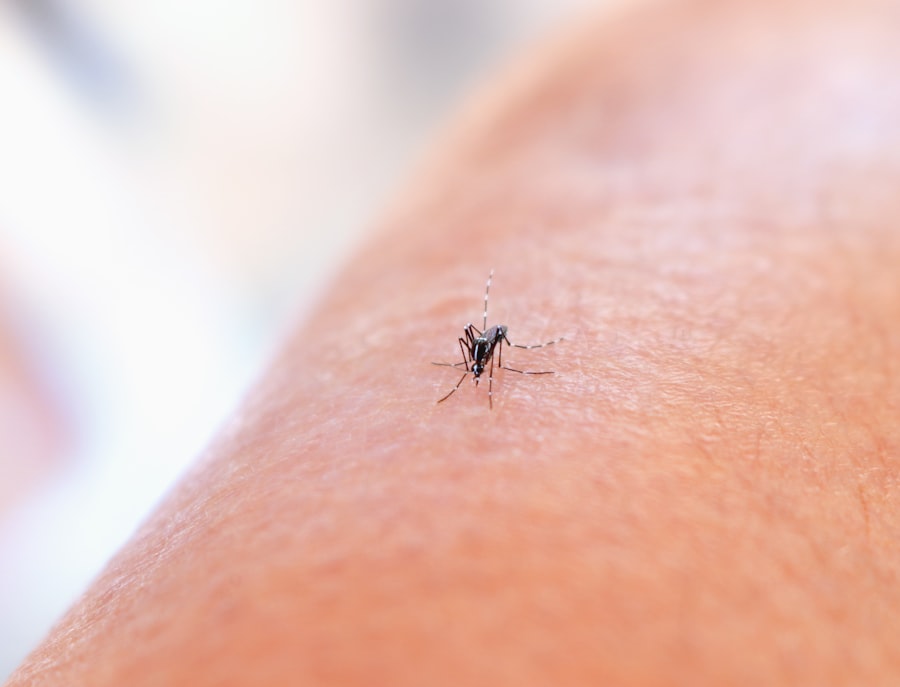
A mosquito trap is a device designed to attract and capture mosquitoes. It works by using various methods to lure mosquitoes towards it, such as the release of carbon dioxide, heat, light, or the use of chemical attractants. Once the mosquitoes are attracted to the trap, they are either trapped inside a container or killed using a mechanism like an electric grid or a fan.
Mosquito traps are an effective tool for controlling mosquito populations and reducing the risk of mosquito-borne diseases. They can be used both indoors and outdoors, depending on the type of trap. By targeting mosquitoes specifically, traps help to minimize the use of harmful chemicals and pesticides that can have negative effects on the environment and human health.
Types of Mosquito Traps: Which One is Right for You?
There are several different types of mosquito traps available on the market, each with its own advantages and disadvantages. The most common types include CO2 traps, UV light traps, propane traps, and electric grid traps.
CO2 traps work by releasing carbon dioxide, which mimics the breath of humans and animals, attracting mosquitoes towards the trap. UV light traps use ultraviolet light to attract mosquitoes, as they are naturally drawn to light sources. Propane traps produce heat and carbon dioxide to lure mosquitoes, while electric grid traps use an electric shock to kill mosquitoes that come into contact with the grid.
When choosing a mosquito trap, it is important to consider its effectiveness and cost. CO2 traps are generally considered to be the most effective at attracting mosquitoes, but they can be more expensive to operate due to the need for carbon dioxide refills. UV light traps are less expensive but may not be as effective in attracting certain species of mosquitoes. Propane traps are effective but require regular maintenance and propane refills. Electric grid traps are highly effective at killing mosquitoes but may not attract as many mosquitoes as other types of traps.
Other factors to consider when choosing a mosquito trap include the size of the area to be covered, the location of the trap, and the power source and maintenance requirements. It is important to choose a trap that is suitable for the specific needs and conditions of your environment.
The Science Behind Mosquito Traps: Understanding How They Attract and Trap Mosquitoes
Mosquito traps use a combination of methods to attract and trap mosquitoes. One of the most common methods is the release of carbon dioxide, which mimics the breath of humans and animals. Mosquitoes are attracted to carbon dioxide because it indicates the presence of a potential blood meal. By releasing carbon dioxide, traps create an irresistible lure for mosquitoes.
In addition to carbon dioxide, mosquito traps may also use other attractants such as heat, light, or chemical attractants. Heat attracts mosquitoes because they are attracted to warm-blooded hosts. Light can also be used to attract mosquitoes, as they are naturally drawn to light sources. Chemical attractants mimic the scents produced by humans and animals, further enticing mosquitoes towards the trap.
Once mosquitoes are attracted to the trap, they are either trapped inside a container or killed using a mechanism like an electric grid or a fan. Some traps use a fan to suck mosquitoes into a container, where they are then trapped and unable to escape. Other traps use an electric grid that kills mosquitoes upon contact. The specific method used depends on the design and functionality of the trap.
Scientific research has shown that mosquito traps can be highly effective at reducing mosquito populations. Studies have demonstrated that traps can significantly reduce mosquito populations in both residential and commercial areas. This not only helps to control mosquito-borne diseases but also improves the overall outdoor experience for individuals.
Benefits of Using a Mosquito Trap: Why You Should Consider Investing in One
There are several benefits to using a mosquito trap. One of the most significant benefits is the reduction of mosquito-borne diseases. Mosquitoes are known carriers of diseases such as malaria, dengue fever, Zika virus, and West Nile virus. By reducing the mosquito population in an area, traps help to minimize the risk of these diseases spreading to humans.
Another benefit of using a mosquito trap is the improved outdoor experience. Mosquitoes can be a nuisance when spending time outdoors, especially during the warmer months. Mosquito traps help to create a mosquito-free environment, allowing individuals to enjoy their outdoor spaces without the constant annoyance and discomfort of mosquito bites.
Furthermore, mosquito traps are often more cost-effective compared to other mosquito control methods. While initial costs may vary depending on the type of trap and its features, the long-term costs are generally lower than those associated with regular pesticide use or professional mosquito control services. Additionally, traps do not require the use of harmful chemicals, making them a safer and more environmentally friendly option.
Factors to Consider When Choosing a Mosquito Trap: Size, Location, and More
When choosing a mosquito trap, there are several factors to consider to ensure its effectiveness. One important factor is the size of the area to be covered. Different traps have different coverage areas, so it is important to choose a trap that can effectively cover the desired area. For larger areas, multiple traps may be necessary.
The location of the trap is also crucial for its effectiveness. Mosquitoes are more likely to be found in areas with standing water or dense vegetation, so placing the trap in these areas can increase its effectiveness. It is also important to place the trap away from areas where people gather, as this can attract mosquitoes towards individuals rather than trapping them.
The power source and maintenance requirements of the trap should also be considered. Some traps require electricity or batteries to operate, while others may require propane or carbon dioxide refills. It is important to choose a trap that is compatible with the available power source and that has maintenance requirements that are manageable for the user.
Tips for Setting Up Your Mosquito Trap: Maximizing Its Effectiveness

To maximize the effectiveness of your mosquito trap, proper placement is key. It is recommended to place the trap in an area where mosquitoes are likely to be found, such as near standing water or dense vegetation. Placing the trap in a shaded area can also help to attract mosquitoes, as they are more active during cooler times of the day.
Regular maintenance and cleaning are also important for keeping your mosquito trap in top condition. Emptying and cleaning the trap regularly will prevent the buildup of dead mosquitoes and other debris, which can reduce the trap’s effectiveness. It is also important to replace any worn-out parts or attractants to ensure optimal performance.
Using attractants can also help to increase the effectiveness of your mosquito trap. Some traps come with attractants included, while others may require separate purchases. Attractants can include chemical scents that mimic human or animal odors, as well as substances that release carbon dioxide or heat. Using attractants can help to enhance the lure of the trap and increase its ability to attract mosquitoes.
Maintenance and Cleaning: Keeping Your Mosquito Trap in Top Condition
Regular cleaning and maintenance are essential for keeping your mosquito trap in top condition. Emptying and cleaning the trap regularly will prevent the buildup of dead mosquitoes and other debris, which can reduce the trap’s effectiveness. It is recommended to clean the trap at least once a week or more frequently if necessary.
To clean the trap, start by unplugging or turning off the power source. Remove any dead mosquitoes or debris from the collection container using a brush or vacuum cleaner. Rinse the container with water and mild soap, then allow it to dry completely before reassembling the trap.
In addition to regular cleaning, it is also important to replace any worn-out parts or attractants. Over time, the attractants used in the trap may lose their effectiveness, so it is important to replace them as needed. Check the manufacturer’s instructions for guidance on when and how to replace parts and attractants.
During the off-season, it is important to properly store your mosquito trap to ensure its longevity. Clean the trap thoroughly before storing it in a cool, dry place. Remove any batteries or propane tanks and store them separately. It is also a good idea to cover the trap with a protective cover to prevent dust and debris from accumulating.
Safety Considerations: Ensuring Your Mosquito Trap is Safe for You and Your Family
When using a mosquito trap, it is important to take safety precautions to ensure the well-being of you and your family. One important consideration is the use of non-toxic attractants. Some traps use chemical attractants that may be harmful if ingested or inhaled. It is recommended to choose traps that use non-toxic attractants to minimize the risk of exposure.
Placement of the trap is also important for safety. It is recommended to place the trap away from areas where children and pets play to prevent accidental contact with the trap or its components. Additionally, it is important to follow the manufacturer’s instructions for safe installation and operation of the trap.
Proper disposal of dead mosquitoes is another safety consideration. Dead mosquitoes can carry diseases, so it is important to handle them with care. Use gloves or a tissue when emptying the collection container and dispose of the dead mosquitoes in a sealed bag or container. Wash your hands thoroughly after handling dead mosquitoes.
Common Misconceptions About Mosquito Traps: Separating Fact from Fiction
There are several common misconceptions about mosquito traps that need to be addressed. One myth is that mosquito traps attract more mosquitoes to the area. In reality, mosquito traps are designed to attract and capture mosquitoes, reducing their population in the surrounding area. They do not attract more mosquitoes than would naturally be present.
Another myth is that mosquito traps are harmful to beneficial insects. While it is true that some traps may inadvertently capture beneficial insects, such as bees or butterflies, the overall impact on these populations is minimal. Mosquito traps are designed to specifically target mosquitoes and are not harmful to other insects when used properly.
Lastly, there is a misconception that mosquito traps are expensive to operate. While there may be initial costs associated with purchasing a mosquito trap, the long-term costs are generally lower than those associated with regular pesticide use or professional mosquito control services. Additionally, traps do not require the use of harmful chemicals, which can save money on pesticide purchases.
Enjoying a Mosquito-Free Environment with the Help of a Trap.
In conclusion, mosquito traps are an effective tool for controlling mosquito populations and reducing the risk of mosquito-borne diseases. They work by attracting and trapping mosquitoes using various methods such as carbon dioxide release, heat, light, or chemical attractants. By targeting mosquitoes specifically, traps help to minimize the use of harmful chemicals and pesticides.
When choosing a mosquito trap, it is important to consider factors such as effectiveness, cost, size of the area to be covered, location, and power source requirements. Proper placement and regular maintenance are essential for maximizing the effectiveness of the trap. It is also important to take safety precautions when using a mosquito trap to ensure the well-being of you and your family.
Investing in a mosquito trap can provide several benefits, including the reduction of mosquito-borne diseases, an improved outdoor experience, and cost-effectiveness compared to other mosquito control methods. By creating a mosquito-free environment, traps allow individuals to enjoy their outdoor spaces without the constant annoyance and discomfort of mosquito bites.
